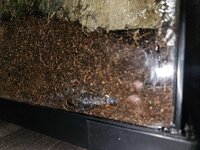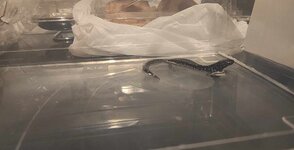SaltSalamander
New member
Hello!
3 weeks ago my husband and I found a blue spotted salamander, possibly a Tremblay's salamander, smallmouth salamander, who knows. Either way, it was on the concrete sidewalk, far, far away from any dirt or water, in zero Celsius temperature and with snow on the ground. It has one eye, a bit of a lump in his tail. He didn't move much when we first picked him up. As he got warmer, he moved around more. We put him in a bit of dechlorinated water, then later moved him to an actual tank we set up that had some natural grass and whatnot. We then moved him to a 10 gallon aquarium, with coco coir substrate, frog moss, and a small puddle of water in a shallow bowl.
We have gotten worms to try to feed him with... Earth worms, specifically. He hasn't eaten any. I put in a much smaller one that I cannot find, but I suspect it's burrowed into the substrate. Which is where he is - burrowed. He is hiding deep in there. I dropped the mini worm right onto him and he might have eaten it but maybe not. He's in the quiet part of the house, our bedroom, where the lights are usually off, the temperature is 18 Celcius, and he's left alone.
I know he's alive because yesterday he showed up in the side of the tank in a little burrow. I put a tiny worm directly into it - a red wiggler. It's now snuggled against his face and he's showing zero interest in any food. I don't want to bother him or try to force him to eat. I can't verify if he's eaten. He doesn't really come out of his hole.
I'm just wondering if there's anything I should try or just let it be? We plan to release him back into nature in the spring, when the snow is gone and it's nicer out.
Attached is some photos of his current position and him when we first found him.
3 weeks ago my husband and I found a blue spotted salamander, possibly a Tremblay's salamander, smallmouth salamander, who knows. Either way, it was on the concrete sidewalk, far, far away from any dirt or water, in zero Celsius temperature and with snow on the ground. It has one eye, a bit of a lump in his tail. He didn't move much when we first picked him up. As he got warmer, he moved around more. We put him in a bit of dechlorinated water, then later moved him to an actual tank we set up that had some natural grass and whatnot. We then moved him to a 10 gallon aquarium, with coco coir substrate, frog moss, and a small puddle of water in a shallow bowl.
We have gotten worms to try to feed him with... Earth worms, specifically. He hasn't eaten any. I put in a much smaller one that I cannot find, but I suspect it's burrowed into the substrate. Which is where he is - burrowed. He is hiding deep in there. I dropped the mini worm right onto him and he might have eaten it but maybe not. He's in the quiet part of the house, our bedroom, where the lights are usually off, the temperature is 18 Celcius, and he's left alone.
I know he's alive because yesterday he showed up in the side of the tank in a little burrow. I put a tiny worm directly into it - a red wiggler. It's now snuggled against his face and he's showing zero interest in any food. I don't want to bother him or try to force him to eat. I can't verify if he's eaten. He doesn't really come out of his hole.
I'm just wondering if there's anything I should try or just let it be? We plan to release him back into nature in the spring, when the snow is gone and it's nicer out.
Attached is some photos of his current position and him when we first found him.


